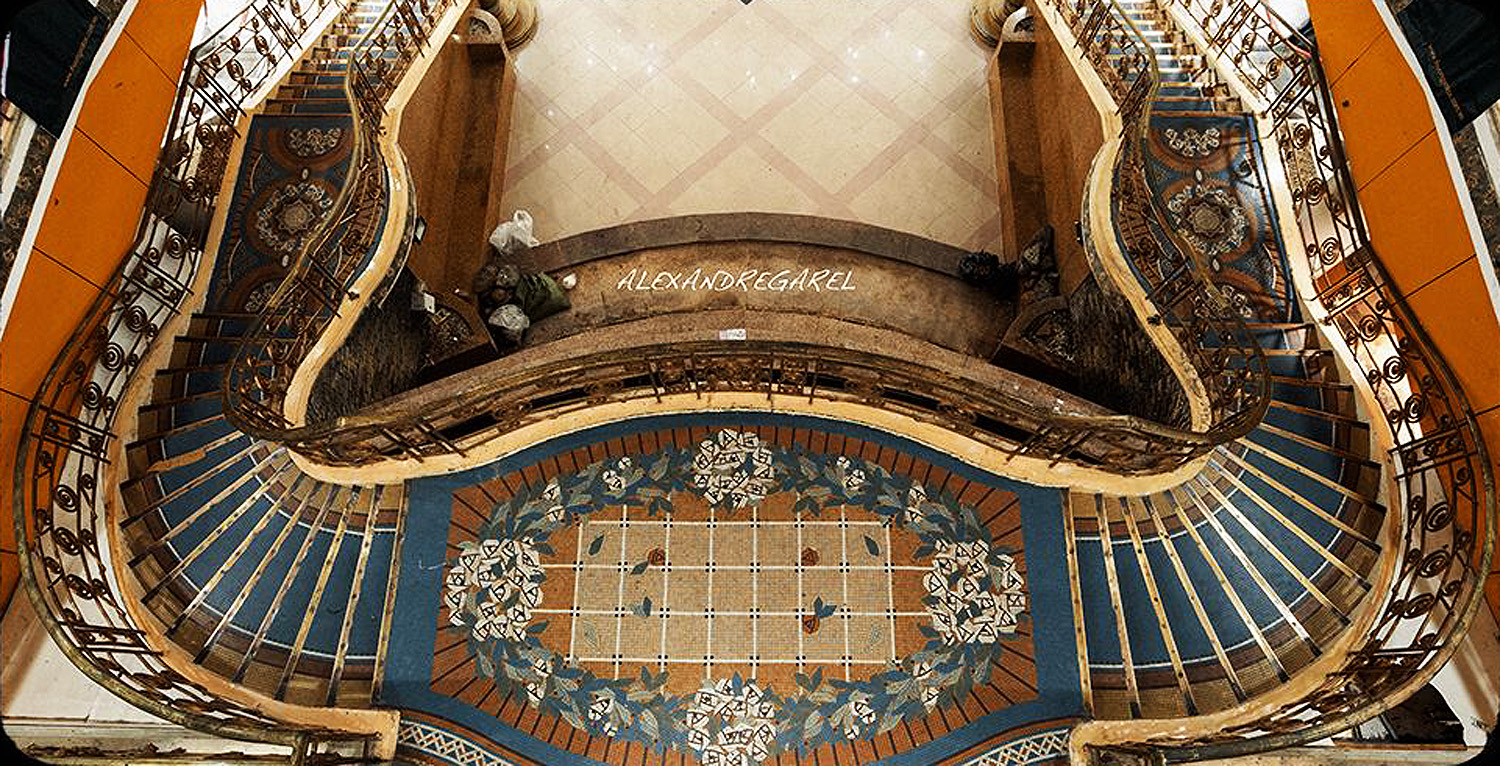
The mosaic staircase, photo by Alexandre Garel
This article by Ms Trần Thị Vĩnh Tường was published previously in Saigoneer.
When the Hồ Chí Minh City authorities announced in 2014 that the Saigon Tax Trade Centre was to be demolished and replaced with a 43-storey tower block, many voices were raised in opposition to the demise of yet another piece of old Saigon heritage. But it quickly emerged that this was not just any piece of old Saigon heritage – the 1924-built French department store housed one of the world’s great pieces of mosaic art.
By the early 20th century, France had three North African Islamic protectorates, Algeria, Tunisia and Morocco. Over 70,000 Muslims from these countries gave their lives to protect France during World War I (1914-1918), and in 1922, the French government began construction of the Grande Mosquée de Paris in order to honour this sacrifice. One of the largest Islamic temples in France, it was built in mauresque style and inaugurated on 15 July 1926 in the presence of French President Gaston Doumergue. The mosque was sponsored until 1957 by the Moroccan royal family.
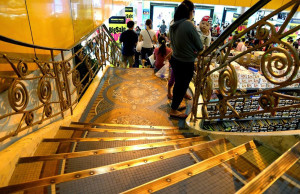
The mosaic staircase by Dona Đỗ Ngọc http://donadongoc.blogspot.com/
From the 1920s, art from the Maghreb was also used by the French for decorative purposes in a variety of civic buildings, both in France and in its overseas colonies. One of the most important examples is the great staircase of the Grands Magasins Charner (GMC), now the Saigon Tax Trade Centre.
The Société des Grands Magasins Coloniale purchased the land on the corner of boulevards Charner and Bonard in Saigon in 1921, and in the following year they began construction of the GMC store, which was similar in design to the company’s existing Grands Magasins Réunis department store in Hà Nội. According to an article of 14 June 1925 in Les Potins de Paris, the GMC was built over a period of two and a half years, from 1922 to 1924. In this way, almost exactly 90 years passed between its inauguration day on 26 November 1924 and its closing day on 25 September 2014.
Taking pride of place in the GMC lobby was the grand mosaic staircase, complete with decorative bronze railings. Though long regarded as an artwork of great beauty, the origins of this staircase were quickly forgotten, and only when the fate of the Saigon Tax Trade Centre was announced was its importance reassessed.
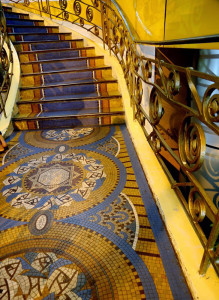
The mosaic staircase by Dona Đỗ Ngọc http://donadongoc.blogspot.com/
Last September, following the permanent closure of the Saigon Tax Trade Centre, a young Saigon architecture student sneaked into the deserted building to say goodbye to it. Like others, he touched the stairway, took a few last photos, tried to memorise the mosaic patterns… It seemed that over the next few days it would all be gone. Nothing but emptiness, like a shell on the seashore. Then on the floor he noticed a loose mosaic piece which had worked its way loose during the moving of loudspeakers at the closing ceremony. He picked it up and pocketed it as a last memory of “Tax.” He noted: “This mosaic piece is irregular-shaped, measuring around 16mm by 17mm, and of nearly 5mm thickness, stamped with the letter ‘H.’”
When this young architect sent me the picture of the loose mosaic piece along with a shot of the whole mosaic on the stairway, I immediately recognised that they were of Moroccan origin. This made me so curious that I began to research their history. Then on 10 November 2014, I met with 35-year-old Faissel Farhi, owner of Zellij Gallery in West Hollywood, California. A native of Morocco, Faissel had been born and raised in the capital of Fes and moved to the USA at the age of 18 to study.
Seeing the brown terracotta, Faissel realised at once that this mosaic piece had been made with clay from his hometown of Fes. The unevenness of the size and glazed colours of the piece suggested that it was handmade.
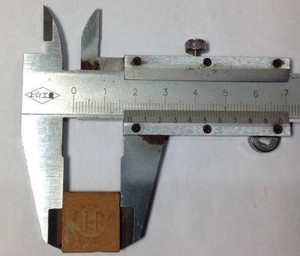
Saigon, 25 September 2014, Private collection, Vĩnh Tường
To my delight, Faissel confirmed my suspicion that the great staircase of the Grands Magasins Charner-Saigon Tax Trade Centre was nothing less than a prime example of the ancient Moroccan mosaic art of zellij الزليج, a speciality of his hometown of Fes, created using tiny enamel-covered chips known as tessera (plural tesserae).
The city of Fes was founded by the Idrisid dynasty in 789 and continued to be the capital of Morocco until 1925 under the French protectorate. Always a multicultural city with a population made up of Arabs, Berbers and other ethnicities, it has been called the “Athens of Africa,” mostly on account of its vibrant artistic and architectural heritage.
One of its best-known forms of artistic expression is the mosaic art of zellij, which dates back at least 1,200 years and is synonymous with exquisite craftsmanship. Originally created exclusively for royalty or high ranking officials, zellig has always been regarded as symbol of noble qualities, sophistication, wealth and high social status.
Since ancient times, zellig has been created by Maalem or Masters – the title Maalem was awarded only to artists whose age and experience qualified them to wear white aristocratic robes. Faissel’s father and grandfather were both recognised as Maalem for their work decorating a variety of Islamic temples and palaces belonging to local aristocracy. The artist would conceive the design of the mosaic entirely in his head. The only way to make sketches was to draw in the sand or earth.
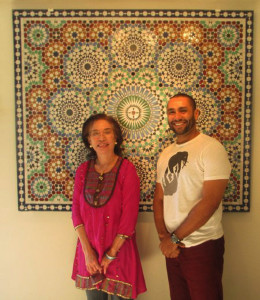
Faissel Farhi and Vĩnh Tường, Beverly Hills, California, 10 November 2014
Traditionally, during the construction of a building, the Maalem would move in and be treated like a family member. He would talk to each member of the household and then seek to encapsulate their feelings and personalities in the designs and contours of the zellig mosaics. If he was still single, a Maalem would sometimes marry the landlord’s daughter. Therefore, Maalem had a strong role to play in the community.
Zellig typically takes the form of a series of patterns which utilise both polygonal shapes and cursive scripts. Such spatial decorations avoid depictions of living things, and as such are consistent with the teachings of Islam.
The earliest zellig were generally of a single colour, but in the 14th century, blue, green and yellow tesserae were introduced under the Merinid dynasty and by the 17th century red tesserae had also become popular.
The technique of creating zellij is very similar to that used in making pottery. The earth used to make the clay base is specific to the region of Fez, and no other type of earth seems to work effectively. It is first mixed with water, then kneaded by hand for a long time before being shaped into tiles 10cm on each side, and approximately 12mm thick. These tiles are then dried in the sun before being enameled and baked in a special oven, fired usually by olive pits. Tiles enameled with different colours are placed in the oven at different levels, so that each is baked at the correct temperature (white on the bottom, green on the top).

Photo: Faissel Farhi private collection
After the tiles are removed from the oven and sorted, they are cut into tesserae. This is done either in a dedicated workshop or directly at the construction site. Apprentices trace the shapes of the tesserae directly on the tile using a template, which is usually an existing zellij tessera. They are careful to mark as many pieces as possible onto each tile.
Then the tile is passed to the cutter, who sits cross-legged in front of a simple workbench, which is often merely a pile of stones with a piece of iron or a harder stone projecting out from it to support the tile being cut. The tool used to cut the tile looks like large wide hammer, carefully sharpened at each end. Its weight and size contrast greatly with the small and delicate pieces being cut.
After the zellij tesserae have been cut and their edges filed, they are placed in baskets, sorted by shape and colour. A craftsman can cut up to 400 tesserae per day.
According to Faissel, one of the characteristic features of zellig is the geometric symmetry of many of the patterns achieved by Moroccan artists, despite not having pencils and compasses. If the symmetry is not so strict, this means that the mosaic reflects the influence of Persia, where curves feature strongly in traditional carpet designs. The mosaic in the Tax incorporates many sweeping curved motifs; could its design perhaps have been influenced by Persia?
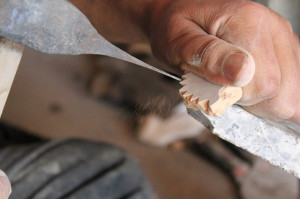
Photo: www.zellijgallery.com/
Faissel conjectures that only one Maalem came out to Saigon to build the GMC staircase, because at that time few Fes artisans would have been prepared to leave their family and country to work overseas. During that period too, Moroccan French speakers were still few in number. We don’t know what the letter “H” stamped underneath the GMC tesserae stands for, but perhaps it refers to the name of the Saigon construction company which worked with the Maalem.
Faissel believes that in the areas of the GMC mosaic staircase which incorporate complex designs, the Maalem used the “indirect method,” which involves laying the tiles face down onto a thin cloth, taking extra care to ensure that the pieces are in the proper order, before the cement is added. This is an area which demands great skill, because once the cement has dried, it is too late to correct any mistakes. After the cement has set, the entire section of mosaic is removed, turned upright and placed in its final position. For the rest of the stairway where there was no design, the “direct method” of building up the mosaic by hand-positioning individual tesserae would have been used.
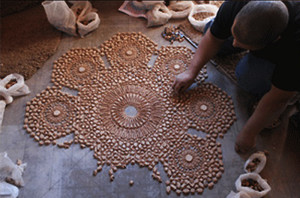
Photo: www.zellijgallery.com/
So, exactly why did the French choose a piece of Moroccan art as a centre piece for the Grands Magasins Charner? We know that mosaic art is one of the oldest and most beautiful art forms known to human civilisation, with a foundation in many early cultures, including those of Ancient Mesopotamia, Egypt, Greece, Rome and Byzantine. What better symbol could they choose to represent the growth and development of Saigon than an art form which represents a synthesis of human civilisation.
Furthermore, the particular design of the mosaic staircase, with its predominant blue colour, shells and fish motifs, seems to bring to mind the great maritime history of Saigon, making the whole staircase an “invitation to the sea.” It’s thus entirely appropriate that in 1925 the French authorities installed a siren on the roof of Grands Magasins Charner to announce when the courier ship from France had docked with its mail and passengers!
According to Faissel, the great value of the Grands Magasins Charner-Saigon Tax Trade Centre mosaic staircase is its uniqueness, since Maalem never created the same pattern twice. He is very touched that Việt Nam has preserved a work of art made from the clay pieces of his homeland for 90 years, and he aims to ensure that the story of this important artwork is known in his homeland and takes its rightful place in the history of the Islamic art of Fes. Faissel Farhi has also offered to manufacture and supply the missing tesserae to SATRA, if needed.
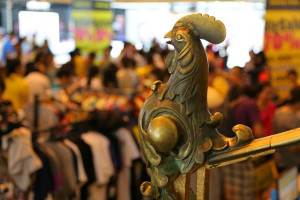
The mosaic staircase by Dona Đỗ Ngọc http://donadongoc.blogspot.com/
Early this year, in the wake of a high-profile public campaign which attracted 3,486 signatures to an online petition, the Hồ Chí Minh City People’s Committee promised to preserve elements of the Saigon Tax Trade Centre in the new building which will replace it, most notably the great mosaic staircase.
From correspondence between myself and SATRA in February 2015, it is understood that the mosaic staircase may need to be removed, stored and then reinstated in the new building. If that is the case, it would be a highly specialised job for which the expertise required is not currently available in Việt Nam.
The conservation group Đài Quan Sát Di Sản Saigon – Saigon Heritage Observatory, of which I am a member, stands ready to assist the building’s owner SATRA in identifying suitable overseas conservation assistance, in order to ensure that the GMC mosaic staircase, that great masterpiece of Moroccan mosaic art, is preserved for future generations to appreciate.
Written by Trần Thị Vĩnh Tường
California, 10 July 2015
Tim Doling is the author of the guidebook Exploring Saigon-Chợ Lớn – Vanishing heritage of Hồ Chí Minh City (Nhà Xuất Bản Thế Giới, Hà Nội, 2019)
A full index of all Tim’s blog articles since November 2013 is now available here.
Join the Facebook group pages Saigon-Chợ Lớn Then & Now to see historic photographs juxtaposed with new ones taken in the same locations, and Đài Quan sát Di sản Sài Gòn – Saigon Heritage Observatory for up-to-date information on conservation issues in Saigon and Chợ Lớn.

